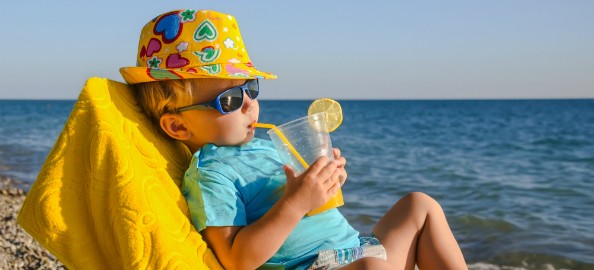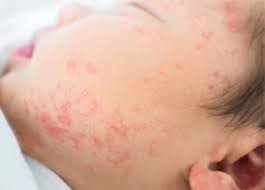As the summer season heats up, you’re probably planning trips to the beach, backyard barbeques and playground playdates.
But the
sunshine brings rising temperatures and even heat waves — leaving you wondering
if it’s ever too hot for your baby to be outside.
Here are
a few key tips to safely head outside with your little one in the heat.
When is it too hot to take my baby outside?
The
American Academy of Pediatrics (AAP) says that children of all ages can and
should play outside when the weather doesn't pose a significant health risk, in
this case defined as when the heat index is below 90 degrees Fahrenheit as
determined by the National Weather Service.
Babies,
toddlers and small children shouldn't be outside for any prolonged period of
time if the heat index is listed as 90 degrees or higher.
How can I protect my child in the extreme heat if I have to go out?
When
planning daytime activities, the AAP says to limit sun exposure as much as
possible between the hours of 10 a.m. and 4 p.m., when the sun is strongest.
That rule
is especially important for infants, who are less able to sweat (the body’s
natural way of keeping your internal temperature down).
Since
that’s a large portion of the day, look for shade if you’re out and about
during those hours with your baby to keep cool and protected in the heat, and
stay inside as much as possible if it's in the 90s or above.
You can take
“baby steps” when introducing your little one to the steamy summer weather.
Start by gradually increasing outdoor time, taking breaks every 15 to 30
minutes during very hot weather. And again, use caution in temperatures
90 or above (or 84 with 70 percent humidity).
If you’re
still unsure about your baby’s safety in the heat, tune into your mom
intuition. If you feel too hot, sweaty or uncomfortable, chances are your baby
does too ... and a little air conditioning may be in order. But if you feel
comfortable outside, it’s likely your baby is too, particularly since babies
aren’t very active.
How can I protect my baby or toddler in the heat in a stroller?
If you're
using a stroller or car seat, consider one with a large canopy that provides
extra sun protection for delicate skin. Canopy extenders can also help keep
your baby shaded from head to toe.
Avoid
draping a blanket over your stroller or car seat for sun protection — even
those made with breathable fabrics — as they can pose suffocation risks, increase
the chance of baby overheating from poor air circulation, and prevent you from
seeing your baby if she’s in distress.
How should I dress my baby in the sun and hot weather?
On very
hot days, follow these tips for dressing baby in the heat:
- Avoid overdressing your baby and leave that extra layer or
light blanket in the car.
- A light-colored, short-sleeved onesie for young babies may be the
best outfit, as long as you can keep your baby out of the direct sun.
- To give your little one's face and neck extra protection, dress
her in a brimmed hat. This is particularly important for infants and
toddlers with little or no hair.
- If you can’t avoid direct sun exposure and your child is younger
than 6 months, dress her in lightweight long pants and a light
long-sleeved shirt. For children older than 6 months, lightweight shorts
and a shirt in a breathable fabric like cotton are best. Look for clothing
with a tight weave (not see-through) for maximum UV protection.
- Wear commercially available sun-protective clothing, like swim
shirts.
What sunscreen can I use on my baby?
Protecting
your baby’s delicate skin is just as important as ensuring she’s comfortable in
the heat. After all, it takes just 15 minutes for the sun to damage unprotected
skin. Here are some helpful tips for applying sunscreen on infants:
- Apply a small amount of
sunscreen with an SPF of 30 to 50 to smaller exposed areas, such as the face (nose, cheeks and ears) and hands if your baby
is under 6 months and adequate shade or clothing protection isn’t
available.
- Use chemical-free products
containing zinc oxide and titanium dioxide. These mineral ingredients sit on top of the skin rather than
being absorbed into it, making them easier on sensitive skin.
- Apply 30 minutes before
sun exposure, and reapply often. For
the best protection, cover any exposed skin with SPF 30 to 50 before you
head outside, and reapply every two hours. Even during overcast days, the
sun is stronger than it appears.
- Take special care around
baby’s eyes. Have a squirming baby on
your hands? Wait to apply sunscreen until she’s calmer or have your
partner distract her with a toy. If your baby rubs sunscreen into her
eyes, gently wipe both her eyes and hands with a cool damp cloth.
Signs of overheating in babies and toddlers
Since
your baby or toddler can’t tell you if she’s feeling uncomfortable, it’s
important to keep on the lookout for cues of heat exhaustion or other heat-related
conditions. Warning signs include being very warm to the touch (more than how
your baby’s typically warm belly feels), extreme thirst, sweating, acting very
tired or weak, and showing a general lack of energy.
Since
your baby may just be tired because it’s nearing naptime or she had an exciting
morning, your instinct will tell you if your baby seems more off than usual.
If you
think your child is suffering from heat exhaustion, immediately take her to a
cool place and undress her to help her body shed excess heat. Sponge her down
with cool water (but not cold enough to cause shivering).
Continue
to give your older baby or toddler small sips of water, or your
under-6-month-old infant breast milk or formula. Call the pediatrician right
away if symptoms worsen or seem severe.
Preventing dehydration in babies and young children
Just as
you carry around your trusty water bottle on hot summer days, have fluids
readily available for your baby. Infants under 6 months who aren’t drinking
water should regularly drink breast milk or formula and babies (especially
those 4 to 6 months or older who have started solids) can be given sips of
water on hot days in addition to milk.
If you
live in a particularly hot climate and think your infant might need more
liquids, talk to your doctor about whether you should offer an oral rehydration
solution (like Pedialyte) to replenish lost vitamins.
The
easiest way to tell if your baby is becoming dehydrated is to monitor
how many wet diapers she’s making (just like you did when she was a newborn).
If you’re changing fewer than six wet diapers in a day, offer more fluids.
Other signs to be on the lookout for include:
- A mouth that appears dry and tacky inside
- Few tears with crying
- Less energy and playfulness
It's a
good idea to call your doctor if your child is displaying signs of dehydration
so he or she can do a thorough checkup and offer appropriate rehydration.
If your
baby is displaying severe symptoms of dehydration (a sunken soft spot on
her head is a big red flag) or other symptoms worsen, see the doctor
immediately.
How to protect your baby in a hot car
While an
air-conditioned car is a great escape from the heat, it’s crucial to never leave
a baby in a car, even for a quick dash into the grocery store.
In
moderate sun, a car can become like an oven, rising almost 30 degrees in 20
minutes — extremely dangerous for little ones whose body temperature rises up
five times faster than yours.
Even in
60-degree weather, a car can heat up to over 110 degrees.
Children
dying from heatstroke in cars, either because they were left in a hot car
or became trapped inside, are hitting record highs, according to the National
Highway Traffic Safety Administration (NHTSA).
In 2018,
52 children lost their lives as a result of being left or caught in hot cars,
the highest number in more than 20 years. And 21 child hot car deaths have been
reported in 2019 as of mid-July. Bottom line: Keep your baby and other
children with you at all times when you're going somewhere by car.
As long as you follow these safety guidelines when it gets hot out there, you and your little one will be just fine and can enjoy the warm weather together. As always, talk to your pediatrician if you have any questions or concerns about keeping your baby or toddler safe in the heat.



1 Comments
Informative
ReplyDelete